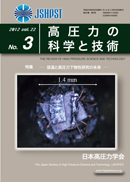Volume 22, Issue 3
Displaying 1-10 of 10 articles from this issue
- |<
- <
- 1
- >
- >|
Foreword
-
2012Volume 22Issue 3 Pages 183
Published: 2012
Released on J-STAGE: September 05, 2012
Download PDF (174K)
Reviews—Future Perspectives of High-Pressure and Low-Temperature Studies—
-
2012Volume 22Issue 3 Pages 185-190
Published: 2012
Released on J-STAGE: September 05, 2012
Download PDF (497K) -
2012Volume 22Issue 3 Pages 191-197
Published: 2012
Released on J-STAGE: September 05, 2012
Download PDF (658K) -
2012Volume 22Issue 3 Pages 198-205
Published: 2012
Released on J-STAGE: September 05, 2012
Download PDF (995K) -
2012Volume 22Issue 3 Pages 206-213
Published: 2012
Released on J-STAGE: September 05, 2012
Download PDF (857K) -
2012Volume 22Issue 3 Pages 214-221
Published: 2012
Released on J-STAGE: September 05, 2012
Download PDF (1085K) -
2012Volume 22Issue 3 Pages 222-228
Published: 2012
Released on J-STAGE: September 05, 2012
Download PDF (902K)
Review
-
2012Volume 22Issue 3 Pages 229-243
Published: 2012
Released on J-STAGE: September 05, 2012
Download PDF (1279K)
Laboratory News
-
2012Volume 22Issue 3 Pages 244-245
Published: 2012
Released on J-STAGE: September 05, 2012
Download PDF (427K)
Salon
-
2012Volume 22Issue 3 Pages 246-247
Published: 2012
Released on J-STAGE: September 05, 2012
Download PDF (541K)
- |<
- <
- 1
- >
- >|
